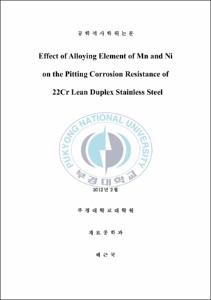Effect of Alloying Element of Mn and Ni on the Pitting Corrosion Resistance of 22Cr Lean Duplex Stainless Steel
- Abstract
- Abstract
The application areas of 22Cr Lean Duplex Stainless Steels (LDSS) are presently growing because of its excellent mechanical property and corrosion resistance in spite of the low cost. Duplex stainless steels have the dual microstructure of austenite and ferrite phases. This steel exhibits generally low thermal expansion coefficients, high corrosion resistance and higher mechanical strength compared with austenitic stainless steels.
The steels used in the investigation have the chemical composition of Fe-22Cr-xNi-yMn-0.2N in which the contents of Ni and Mn were varied while maintaining the equal [Ni/Cr] equivalent. The fraction of ferrite phase was increased with the increase of annealing temperature. 4Mn-2Ni alloy showed the highest pitting corrosion resistance, which should be caused by the highest intergranular energy of ferrite and austenite phases. The fraction ratio, grain size and misorientation angle were measured to investigate the correlation with pitting potential.
Pitting resistance equivalents(PRE) which has been used commonly for evaluation of pitting corrosion resistance could not be applied in this study because of the effects such as various ferrite phase fraction after annealing treatment. The investigation of the effect of Mn and Ni on the pitting corrosion resistance of 22Cr Lean Duplex Stainless Steels (LDSS) was performed by the dynamic potential polarization test to compare the pitting potential of the specimen with the increase of annealing temperature and pitting potential was calculated by the regression model to derive the relation between pitting corrosion resistance and microstructural factors of LDSS such as ferrite phase fraction, Mn & Ni content, gibbs free energy and grain intercept length.
- Issued Date
- 2012
- Awarded Date
- 2012. 2
- Type
- Dissertation
- Publisher
- 부경대학교 공과대학원
- Affiliation
- 부경대학교 재료공학과
- Department
- 대학원 재료공학과
- Advisor
- 안용식
- Table Of Contents
- 1. 서론 1
2. 이론적 배경 4
2.1 듀플렉스 스테인리스강의 개요 4
2.1.1 듀플렉스 스테인리스강의 역사 4
2.1.2 듀플렉스 스테인리스강의 기계적 특성과 부식특성 5
2.2 듀플렉스 스테인리스강의 열역학적 특성 6
2.2.1 Fe-Cr-Ni-Mo-Mn-Si-N-C 8원 합금계의 열역학 수식화 6
2.2.2 부격자 모델(Sublattice - model) 8
2.2.3 Classical Mullins – type GB groove 13
2.2.4 Sublattice – model 과 Mullins – model 의 연관성 15
2.3 결정계면(Crystal interfaces) 17
2.3.1 표면 에너지와 입계 에너지(Intergranular energy)의 관계 17
2.3.2 표면 에너지와 원자간 결합강도(Bond strength)의 관계 19
2.3.3 표면 에너지와 공식전위(Pitting potential)의 관계 20
2.4 전기화학(Electro - chemistry)이론 23
2.5 부식에 영향을 미치는 금속학적 인자 24
2.6 전기화학적 기법을 이용한 공식저항성 측정 27
2.7 회귀분석(Regression analysis) 28
2.7.1 단순선형회귀모형(Simple linear regression model) 28
2.7.2 곡선회귀모형(Curvilinear regression model) 32
2.7.3 중선형회귀모형(Multiple linear regression model) 35
3. 실험 방법 40
3.1 시편제작 40
3.2 미세조직 관찰 40
3.3 열처리 및 Thermodynamic Calculations 41
3.4 페라이트 상분율 측정 41
3.5 동전위분극실험(Dynamic potential polarization test) 42
3.6 EBSD(Electron Backscattered Diffraction) 분석 42
3.7 Grain intercept length 측정 43
4. 실험 결과 및 고찰 47
4.1 어닐링 온도에 따른 페라이트 상분율의 변화 47
4.2 공식전위에 미치는 페라이트 상분율의 영향 49
4.3 페라이트 상분율의 측정 54
4.3.1 페라이트 상분율 측정시스템 분석 54
4.3.2 페라이트 상분율 측정방법간 모평균 차에 관한 추론 55
4.3.3 어닐링 온도에 따른 페라이트 상분율의 회귀분석 56
4.4 공식전위에 미치는 Mn과 Ni 함량 및 M23C6 석출상의 영향 58
4.5 공식전위에 미치는 입계 에너지(Intergranular energy)의 영향 59
4.6 공식전위(Pitting potential)에 대한 회귀모형(Regression model)도출 63
5. 결론 72
6. 참고문헌 76
- Degree
- Master
- Files in This Item:
-
-
Download
 Effect of Alloying Element of Mn and Ni on the Pitting Corrosion Resistance of 22Cr Lean Duplex Stai.pdf
기타 데이터 / 7.38 MB / Adobe PDF
Effect of Alloying Element of Mn and Ni on the Pitting Corrosion Resistance of 22Cr Lean Duplex Stai.pdf
기타 데이터 / 7.38 MB / Adobe PDF
-
Items in Repository are protected by copyright, with all rights reserved, unless otherwise indicated.